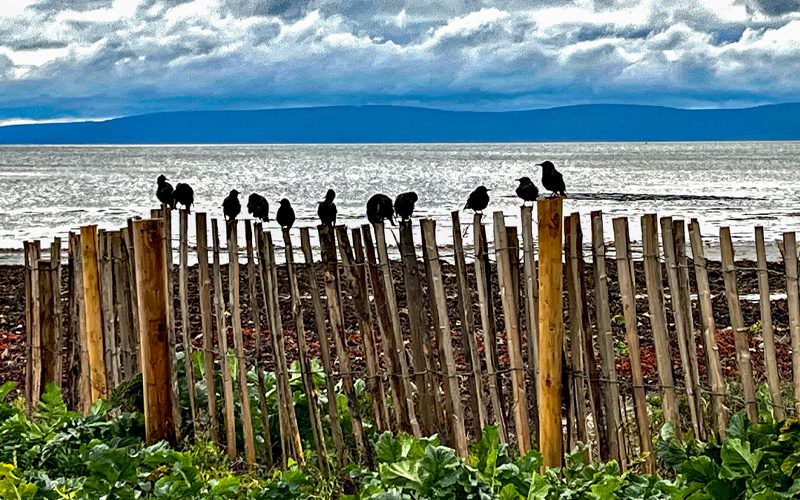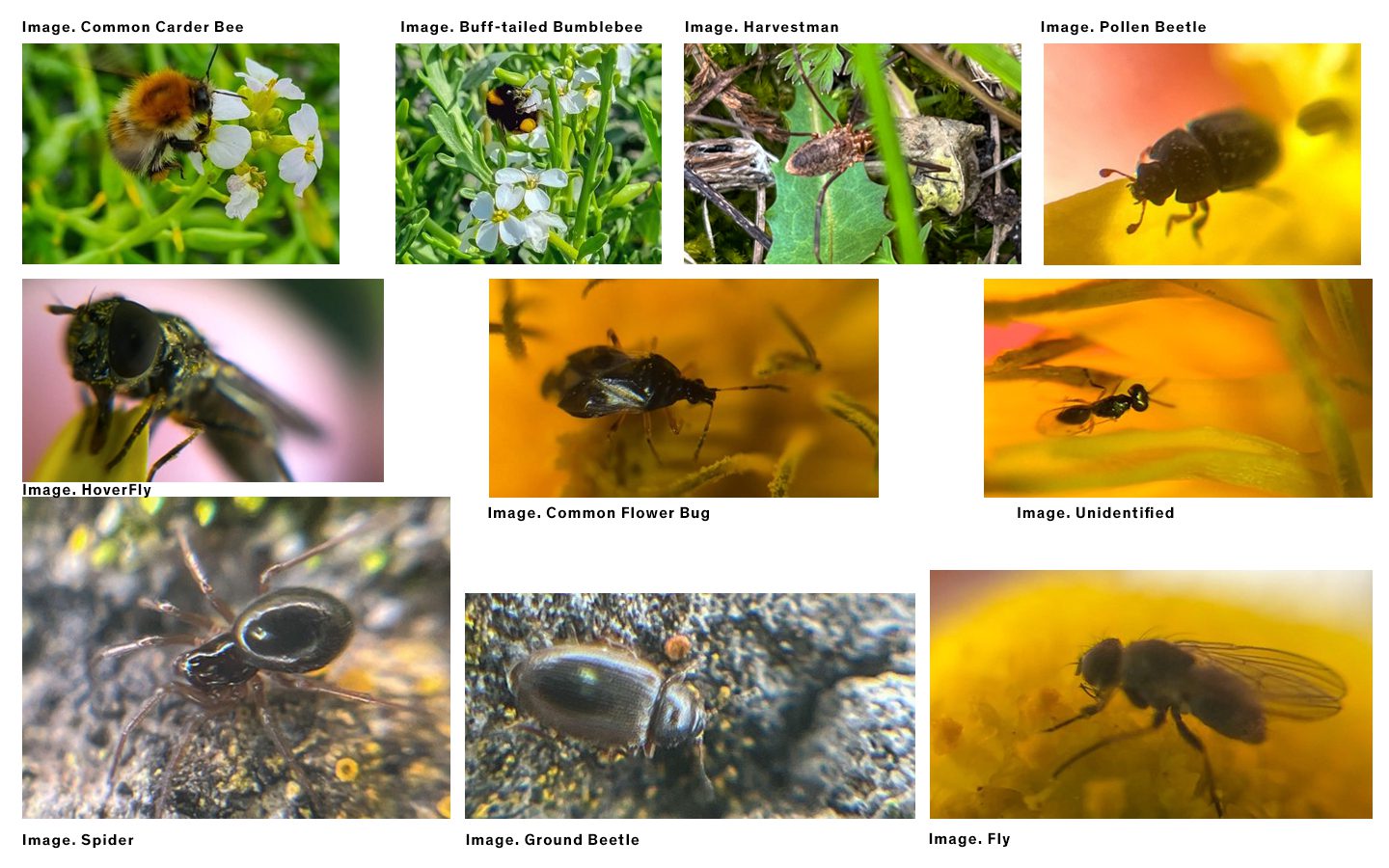Citizen Science & Photography

Showcasing Biodiversity and Dune Restoration in Galway
Reflections on this project’s second year of implementation on Grattan Beach, Salthill

Sand Fence Installation, 13th April, 2024.
On a blustery and cold morning, Galway City Council installed the (Chestnut) Sand Fences on Grattan Beach, Salthill. The task is very difficult, as the fences have to be unspooled, and laid out across over 80+ meters of ground.
Chestnut is used because it is naturally rot-resistant due to its high tannin content, which also makes it resistant to insects, fungi, and decay. This characteristic allows chestnut sand fences to withstand constant exposure to salt, moisture, and harsh coastal weather without needing chemical treatments.
Once the fences are installed, they look quite odd, as they are laid across the sand, and it seems pointless. What are they supposed to do?
Paula Kearney, Biodiversity Officer Galway City Council
There are only three examples of sand dune habitat in Galway Bay, and Grattan Beach near Salthill, west of Galway City supports the only example of embryonic dunes on the coastline.
Coastal sand dunes form when sand from the beach is blown onshore by wind and trapped above the high water mark by seaweed and salt-tolerant plant species adapted to grow in this harsh, dynamic environment. As the sand accumulates, it forms small mounds called embryo dunes. These are the first stages of dune formation.
Coastal dunes protect us against coastal flooding by acting as a barrier to storm surges. While dunes may erode during a storm, the land and infrastructure behind them are protected.
They also provide nesting habitat for coastal bird species including migratory birds. Sand dunes and beaches are also an extremely important recreational resource. However, the dunes at Grattan Beach have been damaged by human activities like foot traffic, litter, and removal of plant species, making them less resilient to wind and wave action, resulting in the sand being blown up onto the road leaving it impassable and blocking road drains, requiring continued maintenance by our crews.
In a bid to tackle the societal challenges arising from the effects of climate change and biodiversity loss, Galway City Council partnered with the University of Galway and Galway Atlantaquaria to build upon the work of the community-led ‘I Like Beaches’ project (since 2012) where local groups have been contributing their ideas to develop a living lab that would make space for nature and visitors on Grattan.
In 2023, consultants ARUP developed a Roadmap for Grattan Beach and Dune site, which sets out the vision for Grattan Beach as a living lab and national demonstration site for Nature-based Solutions (NbS) to tackle the societal challenge of climate change.
A ‘Living Lab’ is where scientists move from the laboratory to the real world to find solutions to problems. The living lab approach allows researchers and community members to gather data, assess the effectiveness of actions, and adapt strategies over time
To deliver the first action for Grattan Beach ‘living lab’ vision, in June 2023, Galway City Council’s Biodiversity Officer, Recreation and Amenity site staff, local community, University of Galway and Galway Atlantaquaria, installed sand fencing to protect and restore the delicate coastal ecosystem while promoting sustainable management practices.
This innovative project involved the installation of strategically placed fencing to help stabilize the sand dunes, preventing erosion, promoting the growth of native vegetation, and creating habitat for rare and protected species. By creating designated pathways for visitors, the project not only preserves the natural habitat but also enhances the overall experience for beachgoers. This collaboration fosters a deeper understanding of coastal dynamics and engages the local community in conservation efforts, ensuring that Grattan Beach remains a vibrant and resilient environment for future generations.

Plant species including sea radish, sea orache, and sea rocket have been established, supporting the dunes and wildlife. Two bird species (house sparrow and greenfinch) on the Birds of Conservation Concern in Ireland 2020-2026 Amber-list species (medium conservation concern) and meadow pipit a Red-list species (high conservation concern) have been recorded in good numbers, feeding in the accumulated seaweed and vegetation.

The return of these species to the area indicates a healthy ecosystem providing for our local wildlife and providing the valuable service of coastal defense.
The success of the project has been down to the engagement and participation of the local community. Stakeholders such as the University of Galway and Galway Atlantaquaria, have captured the evolution of the dunes and showcased the diversity of plant and animal species that have taken up residence in the area.
This amazing catalogue contributes to the scientific monitoring of the project and is a powerful tool for communicating the success of the project to members of the public.
This project has also attracted global interest, with scientists visiting from across Europe and America.

CREATING A PHOTO STORY OF THE PROJECT
If an image is worth a thousand words, 100 pictures will tell a million! We took so many photos of the dunes!
So, the fences were installed, what next?
As this was the second year of the Sand Fence Project, we thought it would be a good idea to photograph each Sand Fence Boundary and see how the dunes develop over time.
Every Saturday we took a photo and managed to stitch them into one time-lapse video.
During the scheduled Time-Lapse Project we were also able to walk across the foredunes and record other impacts of this project on biodiversity, did it help or hinder? We looked at the dunes and fences as a public good. The Sand Fences became a true wonder, as we started to notice its impacts every week.

Questions about the Dunes
Here are some of the top questions asked:
What species of flora would be successful, what will be the colour or theme of the dunes?
Will the new flora around the dunes attract Snails?
How will the fences survive storms?
How can we learn more about dunes and how they work?

We were able to look at the year before and saw that Sea Rocket was the dominant flower. So when we saw the Sea Radish – Yellow Brassicas thrive that was very interesting, and fun to follow the flow of Yellow and White across the dunes.

Image. Brown-Lipped Snail on Grattan Beach.
Over the last few weeks of the project, we started to notice loads of these shells on the shore. As we were used to shells washing up on shore, we thought nothing of it. However, when we tried to ID the shells we could not find the species.
There were some fantastic talks about this, a new Biodiversity discovery!
However, one day while photographing the shells, they moved……and surprisingly there were snails in the upper dunes.
WHY?
Snails choose environments that are suitable for life, therefore the salty conditions are moot, especially when the dunes provide an incredibly tough, resilient environment.
(of all the outcomes of the dune project, we thought the prevalence of snails, was really special)
CAN IT DEFLECT STORMS

The fences are not meant to survive storms, they are meant to encourage dune health, self-heal, promote biodiversity, and encourage flora to create a vast root network to hold the sand together.
(while the dunes can deflect high winds – mitigation, they are not bulwarks like other HTL (Hold The Line) Coastal defenses).

Ammophila arenaria
Over the last two years a patch of Marram has been established at the center of the dunes, this is fantastic news as it can hold the center! It has survived four storms, so it’s a fighter, and will keep the dunes together.
As you can see in the Storm Image, that the deep roots of the Marram stabilsed and held the dunes together.
How can we learn more about dunes and how they work?

We would defer this question to Dr. Kevin Lynch of the University of Galway. Last year the Sand Dune Report was released on The I Like Beaches Facebook Page, and we look forward to the 2024 Report.
https://www.facebook.com/watch/?v=922296619170288&ref=sharing
Dr. Kevin Lynch of the University of Galway has been working on the Grattan Beach Project for many years and writes a host of educational content on a variety of topics, dunes, geology and more.
Follow the Blog Stories.
Welcome to “Beaches and Dunes for Climate Adaptation: Training for Communities,”
We are an innovative and collaborative initiative led by Leave No Trace Ireland in partnership with the Atlantic Seaboard North Climate Action Regional Office (CARO NW), University of Galway, and the Mayo, Sligo, and Leitrim Education and Training Board (MSLETB).

Summary
Being part of the I Like Beaches Project is such an honor and a great learning experience.
As an Aquarium we do look towards the sea, and in doing so we miss much of the Coastal beauty that is right beside/beneath us.
In the last two years of the Sand Fence Project we have seen;
- How NbS Nature Based Solutions can work to help restore beaches, form dunes, become a community resource, and most importantly restore biodiversity along the shore
- How the fences have pushed and consumed Drift Seaweed lower onto the shore
- How the fences have trapped sand, and prevented it from being lost from the shore
- How the fences can work with both the public and nature for the common good


